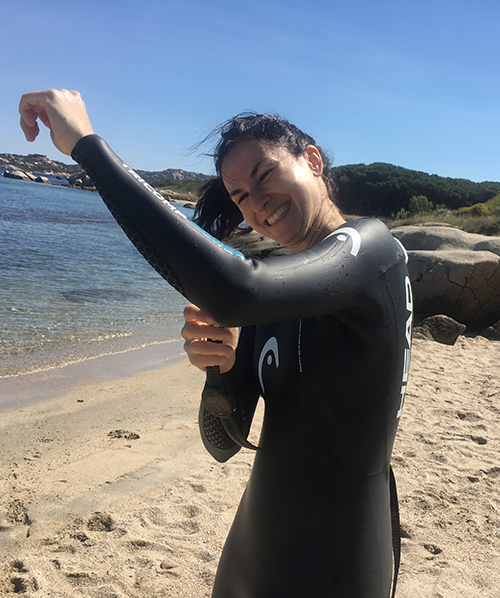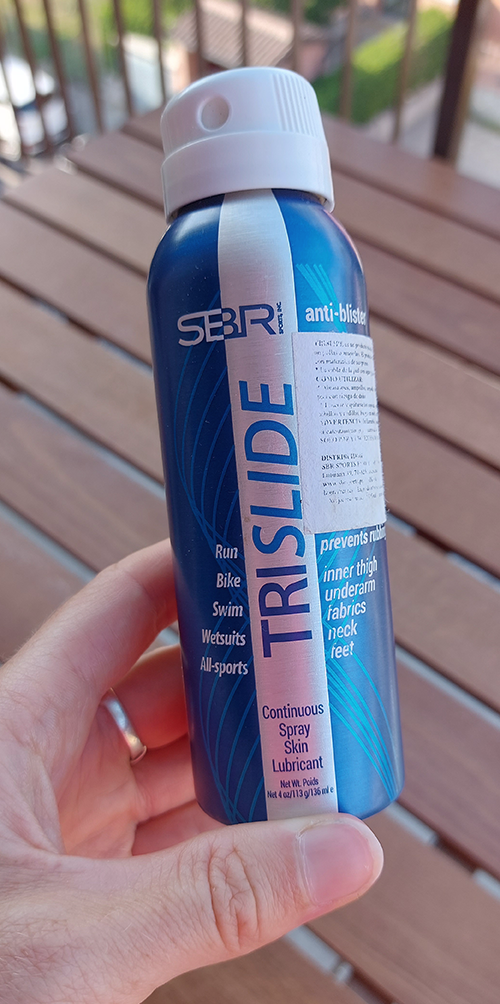The Easy Method to Triathlon Wetsuit dressing.
It’s not often women wear swimming wetsuits, and if it’s the first time, it’ll probably feel quite strange and tight. You also need to be extremely careful with how it is treated as its neoprene material is surprisingly delicate and can rip super easy.
Triathlon wetsuits for women are significantly different to those designed for sailing or windsurfing.
We have found 5 triathlon wetsuit dressing tricks to help us put on our tri wetsuit easily. We also reveal how to avoid friction marks on the skin, especially for the sea swims with that extra salty water!
Just imagine this for a minute. Adrenaline is rushing, you are a little nervous, you’re not thinking straight. You fight with your wetsuit pulling it here and there just to get it on. You make a tear in the wetsuit…and you’re exhausted before you’ve even started the race! Now you’re even more nervous and frustrated.
This post is a step-by-step guide to help you on your way to a hassle-free, enjoyable and energy-saving wetsuit dressing session for all those women out there.




1. Avoid Nails
Nails are a wetsuits worst friend. If you want to make a hole in the wetsuit, just poke your nail into it without much force and tadaaa, you’ve succeeded. But, that’s what we must avoid. Some people actually wear some gloves that are sent with the wetsuit itself once purchased. If you wear the gloves, you are going to be protecting the wetsuit just that little bit more from creating unwanted holes.
2. Use Baby oil or lubricant
Some sort of lubricant is going to help you put the tri wetsuit on, avoid painful friction marks and remove the wetsuit with ease too. It’s something you should always keep in your bag. We bought ours from amazon here. Here’s all the places where we put the lubricant:
- Apply to the back of your neck where the wetsuit closes. We have often come out of a sea swim with very sore friction marks, so don’t forget this area!
- On your forearms, between your wrist and elbow to help your wetsuit slip off easily.
- On your calves, between your ankles and knees, which also helps the wetsuit slip off easily.
- Under the arms where the trisuit touches your skin to avoid rubbing.
3. Use a plastic bag
It’s probably the only time to love a plastic bag, but before slipping that wetsuit on, go and grab a small plastic bag that you can pop on your feet. With your feet covered with the plastic bag, try slipping your feet into the wetsuit and feel how smoothly your foot enters! Once you’ve pulled it up your leg as much as possible, remove the plastic bag and do the same with the other foot! Now you’ve managed to retain your energy, go and swim your best!
4. Just keep pulling
Yes, when you’re on land you may feel like your tri wetsuit is on and you’re ready to go. But wait a second. Move around, move your arms, put them up in the air and do the swimming movement that you will be doing in the water. You’ll probably find that the area around the shoulders is quite tight. A tip here is to start again from the hips and grab as much material as you can and slowly edge up towards your chest and up to free the arms and shoulders more. Then give your arms another swing and see the difference!
Remember, the freer your arms are, the less you are going to have to fight against the wetsuit to swim as smoothly as possible. Energy- saving! After all, you’ll probably have a lot of other things to concentrate on (other swimmers, the waves, the buoys, and the SHARKS or maybe just the jellyfish!) during the race so let’s try to eliminate any possible painful wetsuit problems.
5. Do it up correctly
Different wetsuits have various fastening options. Some zips must be pulled up to close, yet others on the wetsuit close by pulling the zip down. We personally have only had experience with those zipped upwards, but we hear great things also regarding pull-down zips.
Try to get someone to help adjust the material correctly along the back and at the end where the neck is. If the material has lumps and bumps, it will most likely cause rubbing and you will not be as streamlined!
Now what?
Well, now you are wetsuit dressed, it’s time to make sure you can easily remove your wetsuit after the swim section right?
Learn where the string of the zip is that you will need to pull on to unzip. When you’re tired and a little disorientated coming out of the swim, the string needs to be easy to find. Practice grabbing the zip string of the wetsuit a few times so you know exactly where it is and in which direction you need to pull it to unzip. Feel confident you can do this when coming out of the swim exit and you’ll be laughing (at least for that challenge)! Now it’s time to learn how to remove your wetsuit at speed. Although putting on your wetsuit is not timed, the undressing of it will be!


